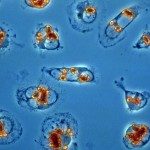Link to Pubmed [PMID] – 24741111
Mol. Cell Proteomics 2014 Jul;13(7):1787-99
Leishmania are obligatory intracellular parasitic protozoa that cause a wide range of diseases in humans, cycling between extracellular promastigotes in the mid-gut of sand flies and intracellular amastigotes in the phagolysosomes of mammalian macrophages. Although many of the molecular mechanisms of development inside macrophages remain a mystery, the development of a host-free system that simulates phagolysosome conditions (37 °C and pH 5.5) has provided new insights into these processes. The time course of promastigote-to-amastigote differentiation can be divided into four morphologically distinct phases: I, signal perception (0-5 h after exposure); II, movement cessation and aggregation (5-10 h); III, amastigote morphogenesis (10-24 h); and IV, maturation (24-120 h). Transcriptomic and proteomic analyses have indicated that differentiation is a coordinated process that results in adaptation to life inside phagolysosomes. Recent phosphoproteomic analysis revealed extensive differences in phosphorylation between promastigotes and amastigotes and identified stage-specific phosphorylation motifs. We hypothesized that the differentiation signal activates a phosphorylation pathway that initiates Leishmania transformation, and here we used isobaric tags for relative and absolute quantitation to interrogate the dynamics of changes in the phosphorylation profile during Leishmania donovani promastigote-to-amastigote differentiation. Analysis of 163 phosphopeptides (from 106 proteins) revealed six distinct kinetic profiles; with increases in phosphorylation predominated during phases I and III, whereas phases II and IV were characterized by greater dephosphorylation. Several proteins (including a protein kinase) were phosphorylated in phase I after exposure to the complete differentiation signal (i.e. signal-specific; 37 °C and pH 5.5), but not after either of the physical parameters separately. Several other protein kinases (including regulatory subunits) and phosphatases also showed changes in phosphorylation during differentiation. This work constitutes the first genome-scale interrogation of phosphorylation dynamics in a parasitic protozoa, revealing the outline of a signaling pathway during Leishmania differentiation. The mass spectrometry proteomics data have been deposited to the ProteomeXchange Consortium (identifier PXD000671). Data can be viewed using ProteinPilot™ software.

